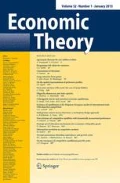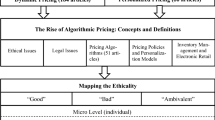Abstract
A potential source of instability of many economic models is that agents have little incentive to stick with the equilibrium. We show experimentally that this can matter with price competition. The control variable is a price floor, which increases the cost of deviating from equilibrium. According to traditional theory, a higher floor allows competitors to obtain higher profits. Behaviorally, the opposite result obtains with two (but not with four) competitors. An error model, which builds on Luce (Individual Choice Behavior, 1959), can adequately describe supra-Nash pricing with a low-floor, but then fails to capture the overall pro-competitive effect of a high-floor seen for duopolies.
Similar content being viewed by others
References
Asheim G.B., Dufwenberg M. (2003): Admissibility and common belief. Games Econ Behav 42, 208–234
Baye M., Morgan J. (2004): Price dispersion in the lab and on the internet: theory and evidence. RAND J Econ 35, 449–466
Bertrand J. (1883): Review of Theorie Mathematique de la Richesse Sociale and Recherches sur les Principes Mathematique de la Theorie des Richesse. J Savants 48, 499–508
Brown-Kruse J., Rassenti S., Reynolds S., Smith V. (1994): Bertrand-Edgeworth competition in experimental markets. Econometrica 62, 343–371
Cason T. (1995): Cheap talk price signaling in laboratory markets. Inf Econ Policy 7, 183–204
Cason T., Davis D. (1995): Price communications in a multi-market context: an experimental investigation. Rev Ind Organ 10, 769–787
Dufwenberg M., Gneezy U. (2000): Price competition and market concentration: an experimental study. Int J Ind Organ 18, 7–22
Dufwenberg M., Gneezy U. (2002): Information disclosure in auctions: an experiment. J Econ Behav Organ 48, 431–444
Fouraker L., Siegel S. (1963): Bargaining Behavior. New York, McGraw-Hill
Goeree J., Holt C., Palfrey T. (2005): Regular quantal response equilibrium. Exp Econ 8, 347–367
Haile, P., Hortacsu, A., Kosenok, G.: On the Empirical Content of Quantal Response Models. Mimeo (2004)
Holt C. (1995): Industrial organization: a survey of laboratory research. In: Kagel J., Roth A. (eds) Handbook of Experimental Economics. Princeton University Press, Princeton, pp. 349–444
Huck S., Normann H.-Th., Oechssler J. (2000): Does information about competitors actions’ increase or decrease competition in experimental oligopoly markets?. Int J Ind Organ 18, 39–57
Ippolito P.M. (1991): Resale price maintenance: empirical evidence from litigation. J Law Econ 34, 263–294
Isaac M., Plott C. (1981): Price controls and the behavior of auction markets: an experimental study. Am Econ Rev 71, 448–459
Isaac M., Walker J. (1985): Information and conspiracy in sealed-bid auctions. J Econ Behav Organ 6, 139–159
Lopez-Acevedo G. (1997): Quantal response equilibria for posted offer markets. Estud Econ 12, 95–131
Luce D. (1959): Individual Choice Behavior. New York, Wiley
Mason C., Phillips O. (1997): Information and cost asymmetry in experimental duopoly markets. Rev Econ Stat 79, 290–299
McKelvey R., Palfrey T. (1995): Quantal response equilibria for normal form games. Games Econ Behav 10, 6–38
McKelvey, R., Palfrey, T., Weber, R.: Endogenous Rationality Equilibrium. Mimeo (1997)
Mullin C., Reiley D. (2006): Recombinant estimation for normal-form games, with applications to auctions and bargaining. Games Econ Behav 54, 159–182
Murphy J. (1966): Effects of the threats of losses on duopoly bargaining. Q J Econ 80, 296–313
Ockenfels A., Selten R. (2005): Impulse balance equilibrium and feedback in first price auctions. Games Econ Behav 51, 155–170
Plott, C.: An updated review of industrial organization: applications of experimental economics. In: Schmalensee, R., Willig, R. (eds.) Handbook of Industrial Organization, vol. II, pp. 1109–1176. Amsterdam: North Holland (1989)
Rogers, B.: Games That Make You Think. Undergraduate Thesis, University of Virginia (2000)
Rosenthal R. (1989): A bounded rationality approach to the study of non-cooperative games. Int J Game Theory 2, 65–67
Selten R., Apesteguia J. (2005): Experimentally observed imitation and cooperation in price competition on the circle. Games Econ Behav 51, 171–192
Siegel S., Castellan J. (1988): Nonparametric Statistics for the Behavioral Sciences. New York, McGraw-Hill
Smith V., Williams A. (1981): On non-binding price controls in a competitive market. Am Econ Rev 71, 467–474
Tirole J. (1994): The Theory of Industrial Organization. Cambridge, MIT Press
Author information
Authors and Affiliations
Corresponding author
Additional information
We thank Jan Bouckaert, David Cooper, Simon Gächter, Reinhard Selten, Frank Verboven, a referee, and the participants at several seminars for stimulating discussions and helpful suggestions. The research has been sponsored by the Swedish Competition Authority. Martin Dufwenberg gratefully acknowledges the hospitality of the Laboratory of Experimental Economics at Bonn University, where he was visiting when part of the research was completed. Rosemarie Nagel acknowledges financial support of Spain’s Ministry of Education under Grants SEC2002-03403 and SEC2005-08931 and thanks the Barcelona Economics Program of CREA for support.
Rights and permissions
About this article
Cite this article
Dufwenberg, M., Gneezy, U., Goeree, J.K. et al. Price floors and competition. Economic Theory 33, 211–224 (2007). https://doi.org/10.1007/s00199-006-0152-0
Received:
Accepted:
Published:
Issue Date:
DOI: https://doi.org/10.1007/s00199-006-0152-0




